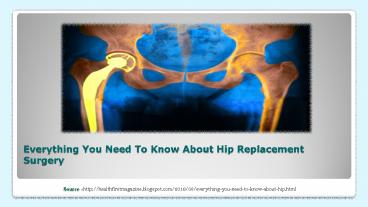Everything You Need To Know About Hip Replacement Surgery - PowerPoint PPT Presentation
Title:
Everything You Need To Know About Hip Replacement Surgery
Description:
The hip joint is the body’s largest ball-and-socket joint. It is designed to withstand repeated motion and fits together carefully to allow movement in our body. You may not think about it but our hips deal with serious stress on a daily basis. – PowerPoint PPT presentation
Number of Views:20
Title: Everything You Need To Know About Hip Replacement Surgery
1
Everything You Need To Know About Hip Replacement
Surgery
Source -http//healthfirstmagazine.blogspot.com/20
16/08/everything-you-need-to-know-about-hip.html
2
- The hip joint is the bodys largest
ball-and-socket joint. - It is designed to withstand repeated motion and
fits together carefully to allow movement in our
body. - You may not think about it but our hips deal with
serious stress on a daily basis. - Even simply walking or running puts a lot of
force on our hips. - In a healthy situation, a cushion of cartilage
prevents friction as the bone moves in the
socket. - Thankfully, our bones and cartilage are both very
durable. - However, the hip joint is not indestructible and
can wear down or become damaged with age. - If you are especially active, the muscles and
the tendons in the hip can also get overused. - In older individuals who develop osteoarthritis,
the hip bone itself can easily be fractured
during a fall. Quality of life can significantly
decrease after a hip fracture. - Big or small, hip pain can impact all aspects of
your daily life.
3
- Depending on what is causing your hip pain, you
might start to feel discomfort in your lower
body your thigh, inside the hip joint, your
groin, outside the hip joint and your buttocks. - Sometimes pain from your back or groin can also
be related to the hip. - If you start to notice that your pain gets worse
with activity, it might be caused by arthritis. - Along with the pain, you could have a reduced
range of motion. Sometimes, people develop a limp
because of the persistent hip pain. - If you have persistent pain that is impacting
your ability to live your life normally, it might
be time for you to get a hip replacement. - During this operation, the surgeon removes the
damaged sections of your hip joint and replaces
them with parts usually constructed of metal and
hard plastic. - This artificial joint, a prosthesis, helps you
reduce your pain and improve function. - Hip replacement surgery can be performed
traditionally or by using a minimally-invasive
technique. - The main difference between the two procedures
is the size of the incision.
4
- Hip replacement surgery has been performed for
over a hundred years. - As well as any other surgical techniques,
techniques are being improved all the time.
Similarly, as any other surgery, there can be
risks. - Since you will not be able to move around a lot
after the surgery, blood clots can be a concern. - To prevent this, your doctor will give you blood
thinners to help prevent blood clots from
occurring. - During the standard hip replacement surgery, the
patient is given general anesthesia to relax the
muscles and to get the patient to a temporary
deep sleep. - The anesthesia will prevent the patient from
feeling any pain or discomfort during the
surgery, as well as preventing any awareness of
the procedure. - A spinal anesthetic can also be given as an
alternative to help prevent pain.
5
- After that, the doctor will make a cut along the
side of the hip and move the muscles connected to
the top of the thighbone to help expose the hip
joint. - Next, the ball portion of the joint is removed
by cutting the thighbone with a saw. - Then an artificial joint is attached to the
thighbone using a special material that allows
the remaining bone to attach to the new joint. - The doctor then prepares the surface of the hip
bone to attach the replacement socket part to the
hip bone. - The new ball part of the thighbone is inserted
into the socket part of the hip. - The doctor then reattaches the muscles and closes
the incision. - After the surgery, you will likely have to stay
in the hospital for a couple of days with a
pillow between your legs to keep the new hip
joint stay in place. - A drainage tube will be placed in your bladder to
help you go to the bathroom. Physical therapy
will begin the day after the surgery and within
days you can start to walk with crutches or a
cane. The physical therapy will continue for
weeks to months following the surgery.
6
- For six to twelve months after hip replacement
surgery, twisting the leg involved should be
avoided. Also, the leg involved should not cross
the midline of your body or turn it inward. - This also includes bending forward at the waist
as well as squatting. - Your physical therapist will provide you with
different techniques and equipment needed to help
you follow the guidelines and have precautions
while performing your daily activities. - Coming back home might be hard after hip
replacement surgery, but there are a couple
things you can do to make life much easier. - For example, you can keep stair climbing to a
minimum. Before coming back home, make the
necessary arrangements so you will only have to
go up or down the stairs once a day. - Another thing you can do is sit firm in a
straight-back chair. - To avoid falls, try and remove all rugs from the
floor to keep it clutter free. - For daily necessities like going to the bathroom,
use an elevated toilet seat. - With this, you will prevent bending too far at
the hips.
7
(No Transcript)































